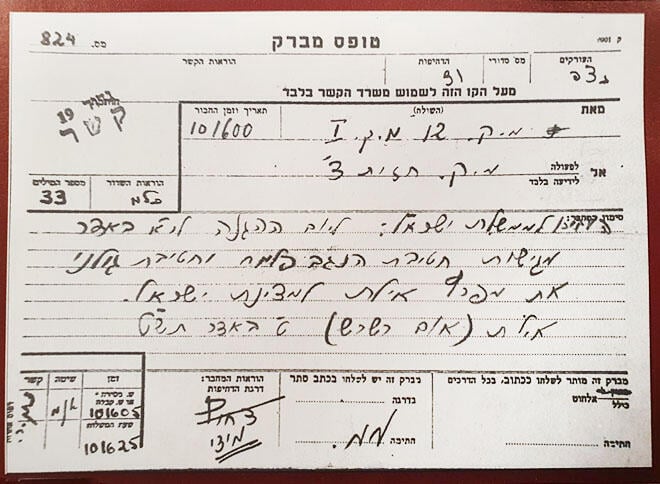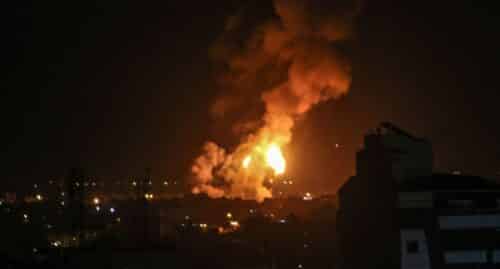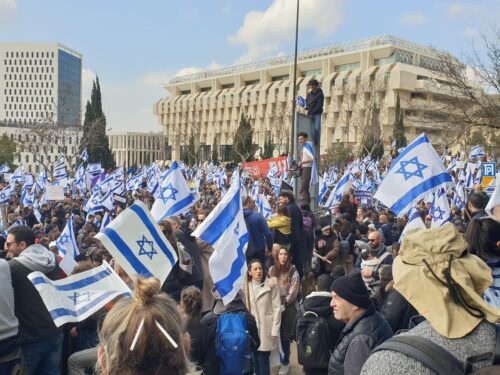
The Swords of Iron War is not Israel’s first prolonged war. The War of Independence, which broke out before the official declaration of the state’s founding was made, lasted around a year and eight months – from November 1947 until the armistice agreements were signed in July 1949.
The operational portion of the war was concluded with Operation Uvda, when Israel established its sovereignty in the southern Negev and southern Arava Valley. Despite the operation’s strategic and political importance, it is currently remembered mainly because of the makeshift Israeli flag that was raised. This flag, which was raised on March 10, 1949, 9th of Adar 5709, was later nicknamed the “Ink Flag”, and became a central symbol of the War of Independence. Documenting the hanging of the flag was also given distinguished status, and to date is considered one of the most iconic photographs in the history of the IDF.
Facts on the Ground: The Backstory for the Operation
Operation Uvda was conducted at the beginning of March 1949. At the time, the armistice agreements between Israel and its neighboring enemy countries began to be signed in an attempt to end the War of Independence. On January 1, 1949, the first agreement was signed with Egypt, and on March 4, talks with Jordan commenced. Already at the start of negotiations it became apparent that Jordan was demanding ownership over the southern Negev, including the city of Eilat. Jordan’s demand won the support of the British, who were very involved in the Kingdom of Jordan, and who strove to create territorial continuity between Transjordan and the Suez Canal, which was to be under their influence.
On the other hand, the State of Israel had strong political and military claims that it needed to control the Negev, and did not intend on relinquishing this control. In order to establish de facto Israeli sovereignty over the Negev, a decision was made to embark on a campaign to take control of the territory on March 6, which was called Operation Uvda.
South of Eilat: How the Operation Unfolded
The goal of Operation Uvda was to reach Umm Rashrash – a small Bedouin village on the coast of the Gulf of Eilat, while taking control of the entire Negev and Arava territories within the Land of Israel. Three brigades participated in the Operation – Negev, Golani, and Alexandroni. The Negev and Golani brigades were meant to reach Umm Rashrash, each moving along a different route. The Alexandroni brigade, however, functioned as a side stabilization campaign operating in the northeast Negev. The air force also participated in the operation, and mainly assisted with aerial reconnaissance and transporting forces and supplies.
The infantry forces began moving southward in the early afternoon hours of March 6. The vanguard forces of the Negev brigade were the first to arrive at the Sde Avraham area, and later in the day they were joined by additional forces from the brigade, along with ground reinforcements of the air force, which helped to prepare the field. Concurrently, the Golani brigade forces advanced in the eastern Negev, and by evening they established themselves the Ein Hatzeva area.
Over the next two days, the Negev and Golani forces continued to advance along their prescribed routes, conquering destinations along the way, including Ein Yahav, Ein Ghamr, and Ein Radyan (now Yotvata). At the same time, the Alexandroni brigade completed the stabilization operation and managed to capture Ein Gedi and Masada without a battle.

The Final Stretch: The End of the Operation and Raising the Flag
On the morning of March 10, military communications discovered that the Arab Legion instructed all of its forces to withdraw east of the international border. Air force patrol revealed that the Jordanian military outpost adjacent to the Egyptian Ras al-Naqb police station had been abandoned.
In light of this information, the commander of the Negev brigade, Nahum Sarig, realized that the forces were close to achieving their goal – capturing Umm Rashrash, however he then noticed that they did not have an Israeli flag to plant there to display their conquest. Sarig instructed his soldiers to create a makeshift flag, which they did. The flag was prepared by the company secretary, Pua Erel. According to her, she used a white sheet that she found and drew a Star of David and two stripes on it with ink.
The makeshift flag was handed to one of the company commanders in the Negev Brigade, Avraham Adan. Complying with Sarig’s instruction, Adan advanced with his forces on foot to Umm Rashrash. Sarig himself advanced to the area in a roundabout way with two jeeps. That same afternoon, a vanguard force of the Negev brigade comprised of 13 officers and soldiers, arrived at Umm Rashrash. They brought with them the makeshift flag the secretary made.
The vanguard force first cleared the buildings in the area, particularly the British police station in the village. Once it was confirmed that the station had indeed been abandoned, the force as able to conduct the flag raising ceremony. Avraham Adan climbed the flagpole that was there and hung the handmade ink-drawn flag. Micha Perry, Deputy Commander of the 9th Battalion of the Negev brigade, who was also a photographer, documented this moment. After the flag was raised, the soldiers there sang Hatikvah.
Despite the successful improvisation, the Ink Flag did not wave from the flagpole for very long. Around two hours after the flag-raising ceremony, Golani forces arrived and brought a proper Israeli flag with them, which replaced the one the Negev brigade made.

The Greatest Event: The Outcomes of the Operation and Commemorating the Ink Flag Ethos
Once Umm Rashrash was captured, Nahum Sarig, commander of the Negev brigade, and Nahum Golan, commander of the Golani Brigade, sent a telegram that said: “On Haganah day, the 11th of Adar, the Palmach Negev brigade and the Golani brigade present the Gulf of Eilat to the State of Israel”.
The next day, Prime Minister David Ben-Gurion wrote in his diary: “This was the greatest event in recent months, if not during the entire war of liberation and conquest”.

Operation Uvda was indeed one of the most important campaigns in the War of Independence, and it greatly shaped the southern border we now know well. Despite Jordan’s initial demands, the armistice agreement Israel signed with Jordan on April 3, 1949 stated that the locations the IDF forces captured during Operation Uvda – including the city of Eilat – will be included in the sovereign territory of the State of Israel.
With regards to the Ink Flag – despite its symbolic and historical significance, it seems to have disappeared during the operation. In fact, for five years no one was even aware of the fact that this was the first flag that flew above the abandoned British police station in Umm Rashrash. Only on March 10, 1954, in an edition of the weekly newspaper Davar LaYeladim that was dedicated to commemorating five years since Eilat’s capture, the photo taken by Micha Perry was published for the first time. This photo was immediately etched into the national memory and became a symbol of the end of the War of Independence.
In 1996, a metal statue created by artist Daniel Kafri was inaugurated at the site of the old police station of Umm Rashrash in Eilat . The statue, which was inspired by Micha’s photograph, depicts Adan hanging the Ink Flag on the flagpole. The Hebrew date on which the flag was raised, the 9th of Adar, was chosen as the official date to celebrate Eilat Day, and this is how the flag







